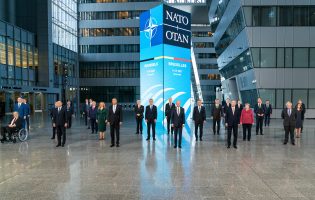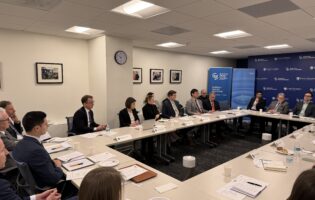New Uncertainties in the Post-Soviet Space
On Friday, May 15, 2009, the American-German Institute (AGI) hosted a public lecture on “New Uncertainties in the Post-Soviet Space: Economic Risks and Political Challenges for the U.S. and Europe,” with DAAD/AGI Fellow Dr. Kai-Olaf Lang and Deutsche Bank/AGI Fellow Dr. Thorsten Nestmann. The lecture was made possible by the generous support of the German Academic Exchange Service (DAAD) and Deutsche Bank Research.
Dr. Nestmann began by discussing the economic situation in Russia and Ukraine, examining both countries’ “booms” followed by economic bust in the wake of the global financial crisis. From 2000 to 2008, both Russia and Ukraine experienced a period of macroeconomic stability: strong gross domestic product (GDP) growth averaging 7 percent; increasing foreign currency reserves from 1998 on; increasing foreign direct investment (FDI); and declining inflation, from 80 percent to 10 percent in 2008. However, both countries’ vulnerabilities led to economic decline in 2008. Dependence on commodity prices adversely affected the economies when oil and steel prices began to fall; dependence on external capital flows caused problems when access to international capital markets became more difficult; and currency depreciation and political instability diminished consumer and investor confidence in the two countries.
Despite similar vulnerabilities in light of the economic downturn, Russia and Ukraine reacted to the crisis differently: Russia began a controlled devaluation of the Ruble, devaluing it in several small steps over three months, while Ukraine allowed uncontrolled devaluation (a condition of IMF support); Russia was in no need of outside support for its economy and industries while Ukraine had to ask for IMF support (and the strings attached to it); and Russia began policies of fiscal stimulus while Ukraine engaged in fiscal restraint, lacking the resources to boost the economy through stimulus packages. As their reactions differed, so too do the challenges facing Russia and Ukraine. First, Russia must ensure “prudent management of its foreign currency reserves” after facing a massive decline in 2008. The reserves are now stabilizing as oil prices continue to stabilize. Second, Russia must ensure the “effectiveness and efficiency of its stimulus packages,” which can be a difficult administrative burden in a weak institutional environment. Third, Russia needs an “exit strategy for state support.” As in the West, the state should outline its plans for extracting itself from the economy. Fourth, Russia must “gain pace with structural reforms,” e.g., start to diversify its economic structure. Ukraine, having accepted IMF support, must “secure further IMF support,” as it was granted a large IMF loan but payment is tied to Ukraine’s economic progress. Second, Ukraine must “safeguard banking sector stability.” Third, it should aim to “avoid further political turmoil.” The upcoming presidential elections are concerning to investors who are wary of political instability. Fourth, as in Russia, Ukraine must “gain pace with structural reforms,” e.g., diversify its economy and improve its financial institutions.
The U.S.’ economic recovery is crucial for Russia and Ukraine, as it can encourage world demand for commodities – essential to Russia’s and Ukraine’s economies. However, there is the chance that both countries will endure an “L” shaped recovery, i.e., a sharp decline followed by a period of prolonged economic stagnation, rather than a quicker “U” or “V” shaped recovery. Still, the economic crisis presents opportunities for Russia and Ukraine to undergo institutional reforms and diversify their economic structures, to the eventual benefit of their economies.
Dr. Lang then discussed the political challenges facing Russia and the European Union with regard to the “near abroad,” over which Russia and the EU are competing to integrate into their political spheres. The EU’s interests in these states range from transit for oil and gas pipelines to assuaging ethnic and intrastate tensions. It is also interested in avoiding a new dividing line in Europe following the 2004 eastern enlargement, with some new member states advocating greater integration for their eastern neighbors (such as Poland’s support for Ukrainian NATO membership), while some older member states are wary of greater integration, fearing political instability in the EU’s backyard.
As a compromise, the EU is looking at a policy of enlargement without accession, offering its eastern neighbors 90 percent of European Union benefits, without being a part of the EU institutions. This includes participation in the EU market, political reforms, participation in EU programs, and financial assistance (approximately €12 billion). The question remains whether this European Neighborhood Policy (ENP) is a pre-accession policy or a permanent alternative to EU membership. The EU’s Eastern Partnership agreements include bilateral relations with its neighbors, as well as a multilateral track with the twenty-seven member states and six neighbors, and aim at offering these countries association agreements with free trade, visa liberalization, and involvement in EU policies, particularly energy policy. As this cooperation begins to have more substance, Russia is voicing objections to the EU’s involvement in its neighborhood.
The U.S.’ interests in the region differ from the EU’s. The U.S. is focused on security, democratization, social and economic reform, and energy (and is less dependent on Russia for energy). First, American engagement in the region is geopolitical while the EU’s is technocratic, utilizing institutions and benchmarks. Second, the U.S. is looking for government and grass roots/civil society cooperation, while the EU is focused on cooperation with governments. Third, the U.S. (under the Bush administration) has engaged in a policy of new containment around Russia while the EU tries to include Russia and avoid antagonizing its largest eastern neighbor. Fourth, the U.S. is particularly concerned about stability in Central Asia, whereas the EU is concerned about the impact on ENP, especially visa regulations and costs.
While these interests differ, the U.S. and EU’s approaches are not so incongruent that they would prevent the U.S. and EU from cooperating to meet their goals of promoting stability, rule of law, and democracy; ensuring energy security, energy transit, and climate change; enhancing transparency in states’ administrations and bureaucracies; and speeding up market reform. First, the U.S.’ approach is in line with ENP and the Eastern Partnerships and it is crucial that the EU extend new association agreements and bilateral relations. Second, together the EU and U.S. need to broaden the dialogue on Ukrainian energy. Third, the U.S. should appoint a special envoy for the eastern region (not just for the Caucasus). Fourth, the eastern countries should be imbedded in the U.S.-EU dialogue on Russia. Finally, the West should undertake visible projects in the eastern countries that should promote the tangible benefits of western engagement, in particular, in health care.
The full impact of the economic crisis on Russia and its neighbors – and the potential political backlash – remains to be seen. In the meantime, the EU and U.S. should engage with the eastern countries in an effort to ensure stability and security in the post-Soviet space.







